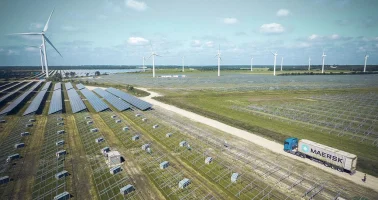12 January 2021
Ambitious targets have been set for the entire AP Moller - Maersk company to achieve net-zero greenhouse gas emissions by 2040, a decade ahead of its initial 2050 ambition. The associated 2030 targets will ensure a world-leading green offering. the sector and a significant reduction in emissions already in this decade.
AP Moller - Maersk (Maersk) announces new emissions targets to align the company with the initiative's Net Zero criteria Science Based Targets (SBTi) to limit global warming to 1.5°C. They include a societal commitment to act now and drive material impact this decade, and a commitment to deliver net supply chains to customers by 2040. The goals go beyond previous efforts to reduce ocean fleet-related emissions, as they cover all direct and indirect emissions from the entire Maersk business.
As a global provider of end-to-end logistics services across all modes of transport, it is a strategic imperative for Maersk to extend our zero emissions ambition to the full footprint of the business. The science is clear, we must act now to make meaningful progress this decade. These ambitious goals mark our commitment to society and to the many customers who ask for zero emission supply chains.
Soren Skou CEO of AP Moller - Maersk
Objectives for 2030 of significant reduction of absolute emissions
Tangible short-term targets for 2030 are set to ensure significant progress in reducing Maersk's direct emissions already in this decade.
These targets include a 50% reduction in emissions per container carried in the Maersk Ocean fleet and a 70% reduction in absolute emissions from fully controlled terminals. Depending on the growth of the maritime business, this will mean a reduction in absolute emissions of between 35% and 50% compared to the 2020 baseline.
Roadmap to achieve the goal of zero emissions in 2040
Our updated goals and accelerated timelines reflect a very difficult, but achievable, path to net zero that is driven by advances in technology and solutions. What is needed is a rapid scale-up that we will strive to achieve in close collaboration with customers and suppliers throughout the supply chain.
Henriette Hallberg Thygesen
General Director of Fleet and Strategic Brands, AP Moller - Maersk
As recommended by the SBTi, over the decade Maersk will go beyond the 1.5°C targets and invest in building a portfolio of natural climate solutions that will deliver around five million tonnes of CO2 savings per year by 2030.
2030 targets to lead the industry in green offerings
To maximize progress towards net supply chains by 2040, ambitious 2030 targets are introduced for a number of green product offerings, adding to solutions such as the Maersk Emissions Dashboard and Maersk ECO Delivery. They aim to strengthen Maersk as the industry's leading provider of green supply chain solutions and cover maritime, air, contract logistics (warehouses and depots) and cold chain businesses (see information box below). These products will use green technologies and solutions to ensure a real reduction in emissions in the supply chain.
Coverage of indirect emissions means that the targets also address emissions from, for example, inland transport services and shipbuilding that are provided by third-party providers. Meeting this challenge will require extensive data availability and close collaboration with local and regional suppliers of products and services across Maersk's business footprint.
Fact box: Maersk's decarbonisation goals
2040
Zero net emissions throughout the business and in all areas
Will align with SBTi net zero criteria
2030
Commitments to customers and society to act now and make an impact this decade
Emissions reduction according to the SBTi 1.5ºC trajectory
- Ocean: ~50% greenhouse gas emission intensity reduction
- terminals: ~70% absolute reduction in greenhouse gas emissions
- Natural Climate Solutions used beyond the 1.5°C target to build a portfolio that generates around five million tonnes of CO2 savings per year by 2030
Green offers for industry-leading customers throughout the supply chain
- Maritime: the 25% of all the transported cargo uses ecological fuels.
- by air: A minimum of 30% of cargo transported using sustainable aviation fuels (SAF) Contract logistics (warehouses and warehouses) and cold chain: Minimum 90% of green operations*
- Ground transportation: Industry-leading green offering – targets to be set during 2022
*Green means that the fuels or energy have low or very low life cycle greenhouse gas emissions.

